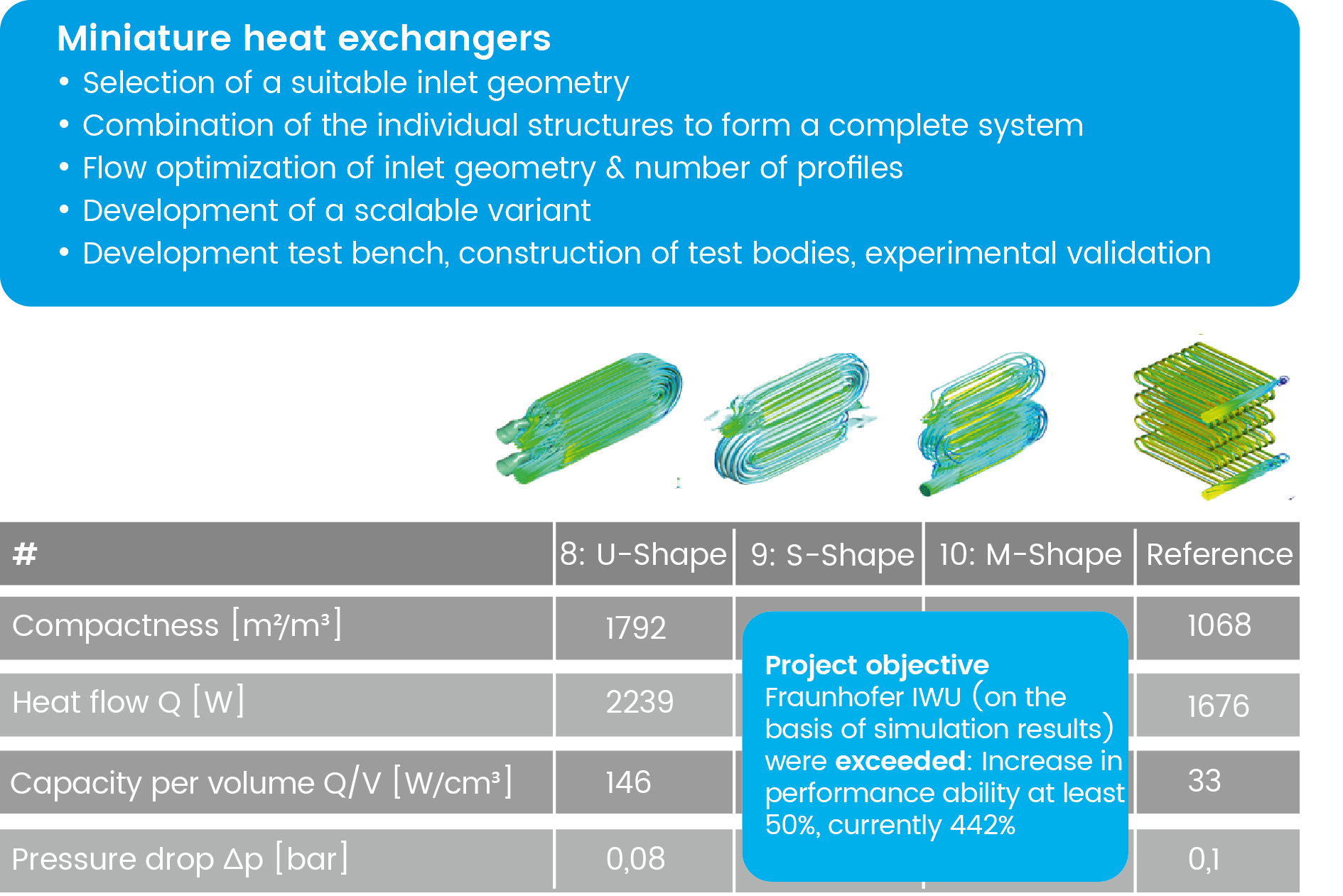Technology Project
AutoHeat

Objective
Autonomous development of individual miniature high-performance heat exchangers
Partners:
Duration: 01.11.2019 - 31.09.2020
Additive manufactured heat exchangers
Additive manufacturing processes are becoming increasingly important and represent an interesting alternative to conventional manufacturing technologies. By adding material layer by layer, the material-saving production of complex components is possible.
Heat exchanger structures are among the complex components. The planned project AGENT-3D_AutoHeat directly uses R&D results from the AGENT-3D project FunGeoS, which were achieved in the sub-project FunGeoS_Fluid for the demonstrator sub-project "Miniature and Micro Heat Exchangers". In FunGeoS, heat exchanger structures were developed, researched and compared. The results of the research work were highly efficient structure variants that could only be manufactured by additive means. In addition, concepts for the design of the (macroscopic) connection geometry and the fluidically favourable geometric transition to the (microscopic) heat exchanger structure were developed and fluidically optimised. In addition, investigations were carried out into the scalability of such miniaturised heat exchanger systems and fundamental findings were obtained with particular attention to efficiency criteria (heat transfer capacity per required installation space, pressure loss).
Objective
The need for an industrial implementation of miniature heat exchangers basically results from the promising interim results of the AGENT-3D FunGeoS project, which go far beyond the originally formulated goals and an increase in efficiency compared to the first additive heat exchanger concept of Fraunhofer IWU used as a reference (see Figure 1).

Figure 1: In FunGeoS achieved results of the developed miniature heat exchangers
The basic project objective of "AGENT-3D_AutoHeat" is the autonomous generation of small, high-performance heat exchangers for specific applications and their adaptation to the individual boundary conditions (available installation space) and requirements (required heat transfer capacity) of the respective application. The required design effort should be significantly reduced and kept to a minimum by using a scalable model (see Figure 1) and a highly effective basic structure as a basis. This is intended to overcome a cost driver identified in the FunGeoS project that stands in the way of an economically viable industrialisation.
However, a further increase in the cost efficiency of the additive production of miniature heat exchangers is necessary in order to be able to successfully industrialise miniature heat exchangers manufactured using additives in competition with existing solutions for cooling, heat dissipation and heat transfer for further use of the heat (plate/foil heat exchangers, heat pipes). For this reason and to generate the optimum functionality for the heat exchangers, an integration and implementation of the heat exchangers in similar systems is planned within the AutoHeat project. In particular, the integration of further functionalities, such as sensors or electromechanical components, allows the creation of compact, problem-solving components.
In the project, a design system is being developed and validated which will allow the transition geometry of the miniaturised heat exchanger structure to the macroscopic coolant connections as well as the deflection of the heat exchanger structure for adaptation to existing installation spaces and for scaling according to requirements to be implemented reliably and additively with minimum space requirements. This also takes into account possible later maintenance, e.g. for cleaning or replacement of possible wear parts.
In addition, a methodology is to be developed with the help of which the miniaturized structures, which have been pushed to the limits of additive manufacturability, are to be checked in their dimensional accuracy and reliable additive manufacturing and, in addition, the influences of different additive manufacturing systems that can potentially be used for manufacturing are to be adequately considered. This methodology is intended to allow a single-machine-specific calibration of the manufacturing process in order to reliably manufacture miniaturized heat exchanger structures and to reliably achieve the performance parameters calculated in the development and design process.
Project partner
The consortium partners of "AGENT-3D_AutoHeat" are partners from the AGENT-3D_FunGeoS consortium (Fraunhofer IWU) as well as project partners who have been specifically added and who have a concrete marketing intention in various fields of application, such as fuel cells (AVL List GmbH), high-performance computing systems (Cloud & Heat GmbH) as well as mobile air conditioning solutions in the work and office environment. This means that the relevant links in the process chain for achieving the project goals are staffed by partners with many years of expertise in the field.